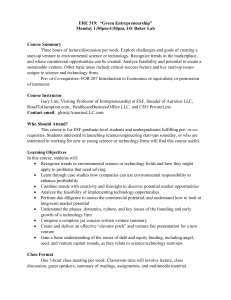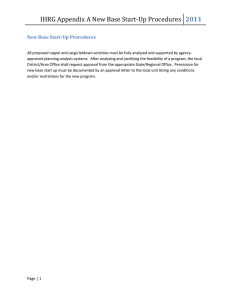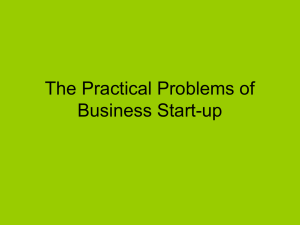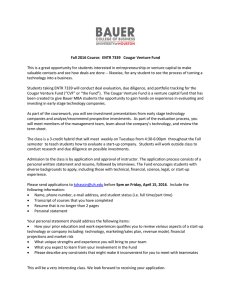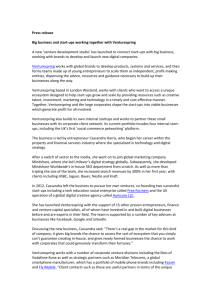Japanese Venture Capital and Start-ups Opportunities for supporting technological-oriented start-ups
advertisement
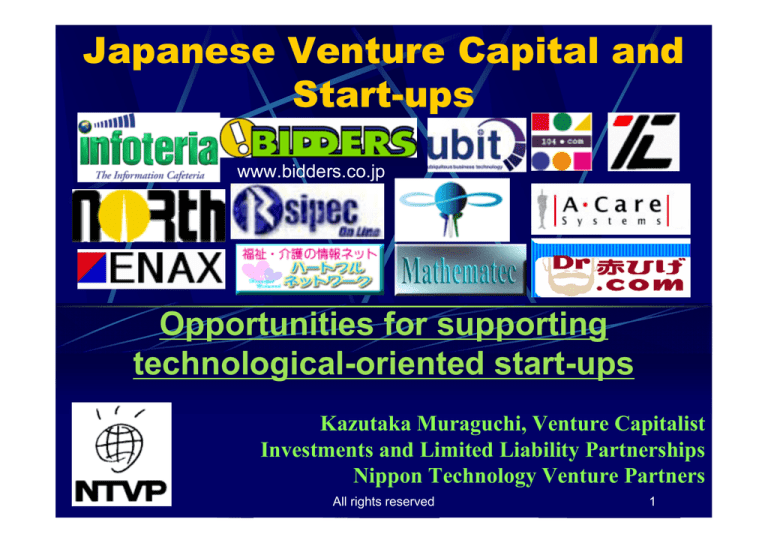
Japanese Venture Capital and Start-ups www.bidders.co.jp Opportunities for supporting technological-oriented start-ups Kazutaka Muraguchi, Venture Capitalist Investments and Limited Liability Partnerships Nippon Technology Venture Partners All rights reserved 1 I. Question in Contemporary History Did American venture capitalism fail in 2000? Was the belief in expert investment appraisers a myth? February 2001 All rights reserved 2 Japan's Historical Turning Point Japanese-style capitalism with socialist-type investment z Features: Fixed exchange rate, labor immobility, control by bureaucracy z z z z Savings absorbed by postal savings and banking for central management and planned investment Postwar recovery period (1945-1960) Accelerated economic growth (1960-1970) High-yen and bubble period (1970-1995) Japanese-style capitalism with private-sector investment z Features: Floating exchange rate, labor mobility, diversity and competition z z z Savings invested by the private sector in diverse undertakings for optimal management Transformation of economic system: Period of confusion (1995-today) Emergence and operation of new economic system (2003- ) All rights reserved 3 Dawning of the Age of Japanese Start-ups 1. Changing industrial structure: Start-ups and major corporations (IT revolution, graying society, globalization) 2. Young leaders of industry 3. Development of investment structure Completely changed from 3 years ago Inflow of investment funds and re-development demand Limited partnership and angel tax breaks, stock options, preferred stock; but problems with LLC and tax system in general 4. Popularization of business models and business plan formulation throughout universities (But, education in capital investment is lacking.) All rights reserved 4 5. New stock exchanges and early assessment infrastructure Need to improve analysts and venture capital companies 6. Role of university reform and corporate restructuring How to improve and expand TLOs 7. Emergence of independent venture capitalists 8. Creating a capital investment cycle (investors Æ VC Æ entrepreneurs Æ IPO Æ investors):problems with tax system Now in the 21st century, is the environment ready for Japan's first independent start-up support system? All rights reserved 5 Outlook for Start-ups in 2003 Second stage in start-up development Poor IPO results, demand for monthly profits Securities industry over-reacts (requirement to erase cumulative losses is unjustified!) Toward highly selective investment strategies (watch cash balances) 2002: Year of growth for surviving start-ups z z z z Strong demand generated by IT revolution Next development stage awaits current process of startup management reform Surviving start-ups are promising Real case studies are beginning to emerge All rights reserved 6 Japan's Failed Capital Investment Education People not taught that "investor" funds finance investments in the future People not taught that the essential function of "shares" is to procure business funds People not taught that everyone is free to establish "limited liability company" and to freely issue shares to procure business funds People not taught about the corporate "management cycle," auditing and the distribution of profits People not taught about the secondary market All rights reserved 7 Youth Entrepreneur Camps (1) Planning Participating youth form groups to develop business plans Our parents were worried, but we can do everything ourselves Presentation, establishing a company, issuing new shares Presentation to student VCs: business plans are adjusted based on investor questions. Participants print stock certificates, register them, issue new shares, and borrow. Purchasing and creating sales outlets Buying in cash, participants go to town to negotiate the best deals. At times, business plans have to be altered right away. "The future is yours to make" All rights reserved 8 Youth Entrepreneur Camps (2) Selling Prices are adjusted with an eye to inventory and demand. Early sales are affected by the weather. Accounting A difficult task to match cash receipts and sales. Accountant prepares an auditor's report. Reporting to shareholders' meeting Profits are distributed as dividends. Best performance does not always go to the smartest students. "The future is yours to make" All rights reserved 9 II. Support for Crossing Valley of Death (1) J-curve and start-up support designed for specific development stages Aiming for listing in roughly 5 years Required funding (Valley of Death) and the need to dig deeper Amount Break-even point Sales Marketing the product Expenses Profit + Time Losses Start-up stage Mass marketing stage All rights reserved IPO stage 10 Stages in Crossing Valley of Death (1) ・ Start-up (technology development) stage: Establish company and develop basic technology for starting business ・ Early (product development) stage: Developing products and services for marketing, establishing manufacturing knowhow and starting marketing. Product services are in place. Losses continue. All rights reserved 11 Stages in Crossing Valley of Death (2) ・ Middle (business development) stage: Launching of full-fledged marketing. Marketing and staff organization developed and company begins to evolve. Key goals include sales growth and rising above break-even. Business begins to take shape. ・ Public (organizational development) stage: Internal control systems, such as cost accounting and monthly control, are gradually developed. Creation of IPO scenario through consultation with securities companies and auditing firms. All rights reserved 12 Inevitable changes = Changing investment needs = Investing in "Points of Growth" Industry and society 10 years ago Population changes Wars Technological Industry Industry progress and and society society Changes in 10 years today consumption from now Decline of the nation Foreign exchange fluctuations All rights reserved 13 III. NTVP's Aggressive Investment Activities Providing value-added in a changing world NTVP portfolio strives to create a wave of start-ups from Japan NTVP's aggressive, critical, independent and individual support scheme “i” independent individuals All rights reserved 14 What is NTVP? "Offering Japanese technologies to the world" NTVP investment partnerships: Mr. Horiba and others’ "Severe individual" Capital z z Venture capital investing (6 billion yen, 10 on-the-scene staff) Mostly in start-up stage (14 businesses) NTVP support z z z z Finance support IPO preparation support Office establishment support Organizing conferences Youth entrepreneur programs, start-up preparation center (Hongo) All rights reserved 15 Independent since April 1998 Worked in major securities company VC section for 14 years before going independent "Individual" is the true source of independence and creativity Independent and individual VC partnerships Went independent concurrently to enactment of Limited Liability Investment Partnership Law All rights reserved 16 Investment and Support Areas of coverage Net enabler z System enabler z Health enabler Accumulating know-how for comprehensive start-up support z z z z Spring 1999 - Summer 2000: New investments phase Fall 2000 - : Additional investments and support phase 2002 - : Business results begin to come in Hands-on investment activities All rights reserved 17 NTVP's Investment Activities www.bidders.co.jp Invested in 14 businesses as of Sept. 2002 (Sept. 1998: XML related infoteria by prominent independent corporate group; Mar. 1999: established DeNA, net auctions; Dec. 1999: established UBIT, Trinity Security Systems; Apr. 2000: established Mathematic, Nitride Semiconductors and others, hi-tech net-related start-ups); North Corporation listed Dec. 10, 2002. Participation in "preliminary preparations“, Appointment as "outside director" All rights reserved 18 NTVP approaches to supporting start-ups Providing ample start-up funds Independent fund provides early stage investment support z Independent approach to investment (technology) z Support for going independent from major corporation Appropriate management for development stage Appropriate Board activities and hands-on approach Results are beginning to come in (North Corporation IPO) All rights reserved 19 NTVP Basic Data Six billion yen fund (individual funds account for more than two-thirds) Investing since 1999; currently invested in 14 businesses Investing 200 - 700 million yen per business Two-thirds are investments in zero-sales businesses; 20% in university-related start-ups Active on Board as outside directors in majority of cases Half of start-up investments have achieved month-tomonth profits In some cases, management is voluntarily passing the baton All rights reserved 20 IV. Understanding How Investments Are Recovered Education is an important element in investment "Due diligence" IMAGINE "Spirit of sharing" "Independence" "Quality of governance" All rights reserved 21 Difference between Investment and Financing Investment…Eyeing a future that is not risk-free and Investment providing funds"without collateral, without guarantees, without repayment schedule and without interest payments in exchange for partial ownership rights." Investment is recovered by: receiving (unlimited) dividends when the business becomes profitable, or by selling part of the ownership rights to other investors. (Investment risks are accepted by investors) Loan…Eyeing a future that is not risk-free and Loan providing funds "with collateral, with guarantees, with repayment schedule, and with interest payments, while maintaining a certain distance from the business itself." Financing is recovered by: receiving (finite) interest payments as agreed upon in the loan contract regardless of whether or not the business is profitable. (Financing risks are accepted by entrepreneurs) Japan managed its postwar economy without educating the people in investment. All rights reserved 22 The Fascinating Thing About the Merchant of Venice— Mismatch of lending and a risky undertaking Anthony the investor Shylock the moneylender Error of going to a moneylender where an investor was needed Choice of investments z z z z z Gold Silver Lead “All that glitters is not gold.” (Other LPs, Board of Directors, etc.) All rights reserved 23 Importance of a Fighting Board of Directors Personnel activities Investment activities Paying for expenses Sales and receiving Bringing together Business operations by executive of capital and knowledge board Rules and regulations Articles of incorporation Accountability Management and support of Board of Directors Management and support of shareholders' general meeting NTVP investment partnerships (Investors' general meeting) Reporting Settlement Investment contract Preferred stock Dividends Other LPs, Board of Directors, etc. All rights reserved 24 VC Limited Liability Investment Partnerships (Capitalism's basic structure) Start-up company Investment Successful development of start-up IPO, selling shares to other investors Participation by supplying outside directors, etc. Accountability Unlimited liability partners (traditionally, individuals) (Management fee) Limited liability partners Limited liability partners Limited liability partners (Source of surplus: Investors) "Independence" is becoming increasingly important All rights reserved 25 V. Investment in North Corporation Buying into an innovative high-precision 3D processing technology All rights reserved 26 Business Outline of North Corporation Developing multi-functional semiconductor packaging parts 1.Bump interconnection (NMBI) business Multi-tiered high-performance printed wiring boards 2.Interposer (UFPL, NMTI) business 3D semiconductor packaging Semiconductor LSI Interposer Semiconductor package Mother board (printed wiring board) All rights reserved 27 I. NMBI (Neo Manhattan Bump Interconnection) —Multi-tiered high-performance printed wiring boards Copper bump based on etching technologies and the world's first open-air Cu-Cu bonding technology NMBI process Copper Copper bumps bumps created created by by etching etching All rights reserved 28 NMBI Business Model Cooperative relations Total control Supplying parts Developing cooperative relations with electronics and printed wiring board manufacturers Cooperating with materials and machinery manufacturers to prevent leakage of proprietary technology Manufacturing parts and not final products: no competitors License businesses Royalty income from patents, technologies, manufacturing know-how All rights reserved 29 Business Model Based on Intellectual Property Printed wiring board manufacturers Decision to adopt technology ② Set manufacturers ④ License provision ③ ③ Equipment manufacturers Delivery Three-tier materials manufacturers ⑥ ⑤ ① Initial license fee Sales Royalty payments on finished products Intellectual property (patents) North Corporation and manufacturing know-how All rights reserved 30 North Corporation listed on Tokyo Stock Exchange Mothers Market in December 2002 Positive response to high business potential of world-class manufacturing technology Listing made possible by achievement of significant amounts of VC funds in Japan New historical development for hi-tech start-ups All rights reserved 31 3 ,0 0 0 M\ North Corporation's Capitalization Policy Successful development of NMBI in June 2000 ÆNTVP Aggressively buying into business potential of new technology: NMBI invests approx. 700 million yen 3 0 ,0 0 0 M\ Contracts signed with NOK subsidiary, Nihon Mektron, and others Sales Recurrent Profit Valuation 2 ,5 0 0 M\ 2 5 ,0 0 0 M\ Business performance 1 ,0 0 0 M\ 2 0 ,0 0 0 M\ 1 5 ,0 0 0 M\ Market value Business performance 1 ,5 0 0 M\ Investment by securities company venture capital division Market value 2 ,0 0 0 M\ 5 0 0 M\ 1 0 ,0 0 0 M\ 0 M\ 1998/09 1999/09 2000/09 2001/09 2002/09 5 ,0 0 0 M\ - 5 0 0 M\ - 1 ,0 0 0 M\ Pursuit of strategic and dynamic "independent business activities" made possible 0 M\ All rights reserved 32 Historical Significance in Development of Japanese Start-ups Japan's first IPO in a non-niche state-of-the-art market where major corporations abound; public listing of a technology-based start-up aiming to beat major corporations in establishing de facto global standard. R&D type start-up with large funding demands; succeeded in winning international competitive position by taking full advantage of funds provided on the basis of plan evaluation. Results in manufacturing industries require time. But North Corporation was able to effectively develop its business model for speedy achievement of IPO. All rights reserved 33 Characteristics of the Case (North Corporation) Invested in new technologies before proven results z New business field lacks data and has few believers Start-up investment = allows preparation in competition-free environment Obvious when you come to think of it Independent business management can be preserved if adequate preparatory capital is available Management able to concentrate on business development As a result, was able to commercialize unique technology All rights reserved 34 VI. Managing a Venture Capital Fund Success in venture capital requires sharply honed instincts Results vary widely among managers Extremely complex, dynamic and humanbased Limits to formal reporting methods VCs receive numerous investment inquiries Success requires high level of enlightenment (deep understanding) All rights reserved 35 Conditions for Success Management: An enlightened individual with welldeveloped sense of balance z z Legal mind and awareness of risk: Mental robustness Understanding of growth stage and customer-oriented thinking Management team of core members Market must enjoy medium-term growth prospects and have critical scale Clear advantage in product servicing It all boils down to: Courage and perseverance. Maintaining the same level of concentration for 1,000 days and fighting spirit All rights reserved 36 VII. Problem of Financing In Japan today, the government should no longer take direct action. That role now belongs to a highly diverse private sector acting on its own free will and volition. The old socialistic policies of Japan served to block the people from pursuing free and creative activities, nipped the buds of initiative and undermined and weakened the people's will to act. Special importance of “policies designed to stimulate bold and diverse activities by the people.” ÆThe key lies in the people's participation in investment Japan's venture-capital policies must not become a mere chapter in the new-age measures for supporting SMEs. Venture-capital policies must be assigned a position in national policies. All rights reserved 37 Huge Dormant Savings of Japan's Elderly Over-reliance on savings to maximize value of "post inheritance tax" assets z z z Sector has low propensity to consume and wealth effect Infinitesimal interest income is the only contribution to tax revenues Hence, savings of the elderly are being protected injection of public funds to save banks strapped by non-performing loans using taxes paid by working generations. Keen interest in tax saving, and concern with gift and inheritance taxes z z z Even the asset-wealthy are concerned with pensions and use pension benefits to boost savings Avoidance of risk associated with stock investment, and continued preference for government guaranteed postal savings Public's strong preference for safety in fund management feeds the Fiscal Investment and Loans Program which supports inefficient sectors Old style of fund management still prevails in Japan = The main cause of dormant and poorly allocated capital All rights reserved 38 “Problem of SME Financial Structure” Publicly-traded Japanese companies have reached international standards of equity capital ratios. However, Japanese SMEs have low equity capitalization and remain dependent on borrowing. (Weak financial foundations hamper speedy response to changing environment.) Worse yet, unlike publicly-traded companies, borrowing by Japanese SMEs is "backed by personal assets" (banks demand personal collateral and guarantors). This creates structural obstacle to selling off profitable segments of the business. (Change in ownership and management is difficult.) he business may be sound, but companies are saddled with debts from failed investment in bubble years. This prevents SMEs from taking the initiative in structural reform. Difficult for SMEs to avoid bankruptcy if banks stop lending. This weakness generates chain reaction of non-perform loans. (Chain reaction involves individuals also.) All rights reserved 39 Operational Dysfunction of Personal Deposits Held in Banks and Postal Savings Enormous personal deposits dormant in banks and postal savings Financial intermediation function of banks and postal savings stretched beyond capacity On the other hand, risks are climbing due to excess stock portfolio Lending to SMEs is backed by owner's personal guarantee and collateral, leading to over-lending Tax money is used to salvage banks and postal savings suffering dysfunction of financial intermediation function. Situation calls for reaching a sound equilibrium on a lower scale Capital must be effectively invested to create employment All rights reserved 40 VIII. New-Age "Japanese Investor" Requires Effective Support Policies Japanese economy will remain sluggish if the enormous financial assets of the Japanese people are not properly invested and managed Japanese people can no longer allow their financial assets to be invested by the government and its public corporations Basic requirement: Japanese people must be prepared to invest on their own as individuals Defining the "Japanese investor" in the age of individual investment z z Important feature of the Japanese investor: many are elderly In particular, investors capable of accepting high risks tend to be elderly All rights reserved 41 Summarization Proposal for "Law for Promoting Investment in Start-ups" Modify tax filing system to create "investment activities filing page" to provide unified and full-fledged policy support to individuals in creative investment activities (integrate or include angel tax benefits) In particular, in case of new investment in start-up, provide substantial tax breaks at buy-in stage, liquidation stage and in case of bankruptcy In case of major investment activity through partnership, allow management fees to be charged to taxes as expense Allow for differences between preferred and ordinary shares Transfer the functions of public investment institutions to universities Modify LLC laws applicable to venture capital management organizations All rights reserved 42 Accountant: XXXXXXX Name of taxpayer: XXXXXXX Tax Return Form: “Investment Activities Filing Page” (General use) Table of new investments made during filing period Of which, new investments in start-ups Deductible from income or tax Table of outstanding investments at end of filing period Of which, outstanding investments in start-ups Deductible from inheritance tax assets Computation table of capital gains and dividend income during filing period Of which, capital gains and dividend income from investments in start-ups Computation table of bankruptcies and other depreciation during filing period Tax exempt or deductible Chargeable to capital gains income, but must accompany accountant's signature Computation table of management fees and other expenses related to venture capital partnership during filing period All rights reserved Charged to income as expense 43 IX. Conclusion Why are all the stars of the TV program "Project X" series economically disadvantaged ? Japan has 1,400 trillion yen in financial assets, a long tradition of mercantile spirit and culture, technological prowess, and a wealth of human resources Importance of "fighting earnestly for the future" Preface to Cartesian method: Struggle between truth and conventional wisdom All rights reserved 44 Dog years go too slowly! (In pursuit of humanism) Venice Romeo and Juliet met, fell in love, eloped and died, all in three days Silicon Valley's dog year (two months = one year) is too slow The problem is not culture. From the humanist perspective, people have an amazing capacity for speedy response, regardless of race or religion All rights reserved 45 Start-up Deficiency Syndrome (erroneous assumptions) 1 Japanese are from farming culture and are naturally conservative Start-ups are major corporations in miniature form Showing losses is dangerous and proof of unsound business New capital issues in start-up stage at anything above face value is unrealistic Must have MBA or lot of business experience to serve on Board of Directors or to issue shares Venture capital managers, investors and supporters must be really generous and courageous like Americans American banks bet on future prospects and lend boldly America has expert investment appraisers; Japan does not All rights reserved 46 Start-up Deficiency Syndrome (erroneous assumptions) 2 Collateral is needed for receiving VC financing Changing the business plan proves lack of management capability Competition is won on the basis of size, brand strength and tradition. Every market possibility has already been investigated, and every opportunity has already been fully exploited Financial analysis manageable through figures is most important A company that has eliminated autocratic management rule is a good company CEOs of start-ups become rich on high pay Investing in the future is dangerous; stock prices reflect bubble phenomenon Government generates interest payments; trying to recover business investments is risky All rights reserved 47 New Image for the Japanese Capitalist Sensitive to ongoing changes Accepts the role of investor in future possibilities Not tied down by conventional wisdom; has his own vision for venture capital investment Invests in businesses (not in paper securities) and is willing to work on Board of Directors Has the business acumen needed by corporate directors Has detailed knowledge of the stages of start-up business development Strong commitment to compliance and sense of justice Tenacity in pursuit of success All rights reserved 48
